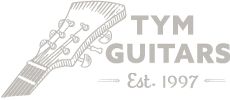TMI Unitone
Share
This one was fun, and a long time coming, but then, that's a lot of my stuff really.

I've loved the Unitone/Astrotone shape since the first time I laid eyes on it years ago. The thing I love about a lot of these mid to late sixties Japanese designs was their willingness to take a risk on design while somehow keeping some traditional points in place. This shape with the bottom horn moved out (or the top horn moved in) would be a fairly traditional shape but with that bottom horn slid back like this it changes the whole design aesthetic and then the scratchplate design sets it all off.

With my TMI guitars I'm basically working with ideas while making stuff I've always loved. All of these designs so far have been hollow or chambered to some degree. Early ones (and future ones) utilized hybrid plastic/aluminium/laminate/MDF materials and then I moved into hollow/chambered laminated designs. Some have been revisiting old friends and some have just been things I've always wanted to build.


This one is very similar to the other TMIs I've build recently being layered laminated bodies with internal bracing and chambers with a centre spine running from the neck pocket to the strap button.

The body shape is almost irrelevant in this method of construction which is why i'm building a bunch of shapes I've always loved.
The main difference in point to past TMIs is the pickups I made for this one. I had intended on making aluminium T-90's but then I got the idea of making some offset T-90s almost like old Maton pickups, which were in metal covers the same size a P-90.

These have a row of steel slugs with a bobbin sitting directly beside them and uses six neodymium magnets for flux. The bobbins are very underwound at under 5K each giving a very broad frequency response. Having the bridge pickup jammed up against this aluminium bridge makes that position very bright but the neck is considerably different and makes the middle position very nice. I'll keep working on this idea as I think I can get some cool sounding pickups out of it.


I initially tried Alnico, ceramic and Neo magnets and mixtures of the three and really liked the ceramic/neo mix but eventually settled on the all neo set up but I will also revisit the ceramic/neo mix in future builds.

The electronics are pretty simple with a volume for each pickup and master tone control. I've wired it so you can blend in the middle position with each volume immune from the other. This gives some pretty cool options.
I love these Bigsby style bridges and I've written about them a lot in other blogs. Having "movement" and vibration across a whole one piece bridge appeals to me a lot and the wraparound, which also has all the tension of the strings on it is my favourite bridge ever with these a close second in the right set up.


The other slight departure on this one is the string hold down bar, which of course is big on sixties Japanese guitars. I made this one to give it that vibe and see what tone differences it gives me from previous TMI set ups. So far I like it more so these may pop up on more TMI builds.


The colour is one I mixed up in honour of my guitar building hero, Semie Moseley. He offered a dark metallic purple as a custom colour at Mosrite that he called California Grape so I made this colour and called it Queensland Grape.

This is a thin and light guitar and resonates well both acoustically and plugged in. The 25.5" scale on all of these helps with "tone" as apposed to some of these vintage Japanese guitars which ran all the way down to 23" on some models, which is too short for me. The original Astro/Unitones were 24.75" which feels a little short to me these days although for many years was my preferred scale.

So, I'll get this to the shop soon for people to try out and get to work on another guitar. I've got three in the works at the moment using different ideas so I'll do blogs when they're ready to show.
